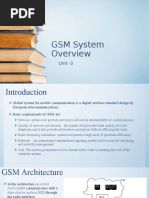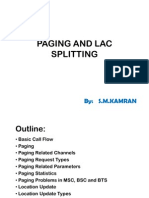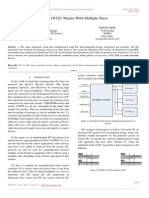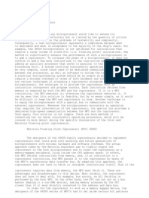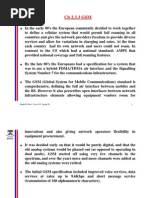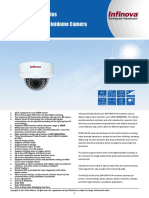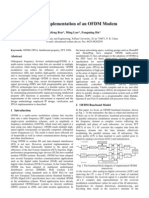Using MC683xx M-Bus Software To Communicate Between Processor Systems
Using MC683xx M-Bus Software To Communicate Between Processor Systems
Uploaded by
Asier ErrastiCopyright:
Available Formats
Using MC683xx M-Bus Software To Communicate Between Processor Systems
Using MC683xx M-Bus Software To Communicate Between Processor Systems
Uploaded by
Asier ErrastiOriginal Title
Copyright
Available Formats
Share this document
Did you find this document useful?
Is this content inappropriate?
Copyright:
Available Formats
Using MC683xx M-Bus Software To Communicate Between Processor Systems
Using MC683xx M-Bus Software To Communicate Between Processor Systems
Uploaded by
Asier ErrastiCopyright:
Available Formats
Freescale Semiconductor
Order this document as AN496/D
AN496/D
Using MC683xx M-bus software to communicate between processor systems
James Gilbert, Applications Group, High-Performance Products, Freescale Semiconductor, Inc. East Kilbride, Scotland.
Introduction
Freescale Semiconductor, Inc...
M-bus is an I2C-compatible bus interface used in the 683xx family. It is a serial interface comprising two open-drain, bidirectional signals, namely serial clock (SCL) and serial data (SDA). Multiple devices can be connected directly to these open-drain lines, and indeed this is good reason for the widespread adoption of the bus as an efcient IC communication method in end-systems. A typical scenario would consist of a processor with an M-bus master controlling the data ow between several slaves, such as LCDs, real-time clocks, keypads, A/D converters and memories. Moreover, a built-in bus collision mechanism supports multiple M-bus masters as well as multiple slaves. The M-bus module of the 683xx is exible enough to operate as either an M-bus master or a slave. This application note demonstrates control software for M-bus communication between two identical MC68307 systems, one congured with an M-bus master and the other an M-bus slave. Only a short piece of initialisation code needs to be changed to make the MC68307 code applicable to other 683xx devices with M-bus.
Overview of M-bus Software Transfer Mechanism
For full details of M-bus features, and a complete specication of the M-bus module, refer to the MC68307 User Manual. For the sake of clarity, a brief overview of the software control mechanism is provided here. The M-bus communication is on a byte-wide basis. The components of the hardware transfer protocol are a START condition, 8 data bits, an acknowledge bit and a STOP condition. Before starting a communication, an M-bus master should carry out a software check to ensure the bus is free, and therefore all other M-bus transfers are complete. Thereafter, the bus master initiates a transfer by software writing a START condition onto the bus. This is an indicator to all connected M-bus devices that this master is taking charge of the bus, and that the address of the targeted slave is to follow. For the 683xx Mbus master, writing the targeted slave address to the data register initiates the 8-bit transfer (MSB rst).
Freescale Semiconductor, Inc., 2004. All rights reserved.
If a system has two or more M-bus masters which poll the bus free and start a transfer at the same time, then the collision detection arbitration, throughout the transfer of the slave address transfer and subsequent data bytes, decides which device gets charge of the bus. If the 683xx M-bus loses arbitration in this way, it stops driving data onto the bus, to prevent data corruption. Furthermore, it switches automatically into slave mode pre-empting the alternate master addressing it as a slave. If interrupts are enabled, an interrupt is generated on the completion of that byte, and a status bit indicates arbitration lost as the interrupt source. The rst data byte transmitted by the M-bus master is always the targeted slave address, with the least signicant bit determining whether the slave remains ready to receive or transmit subsequent bytes. The addressed slave can then acknowledge the received byte, or not, depending upon the software protocol and acknowledge capability of the slave devices used. Each acknowledge is like a 9th data bit, asserted by the receiver as a handshake to successfully transmitted data.
Freescale Semiconductor, Inc., 2004. All rights reserved.
9/95 1995. All trademarks are recognised.
Freescale Semiconductor, Inc.
A block transfer comprising a series of data bytes (and acknowledges, if used) follows as commanded by the software protocol. The bus remains busy throughout the block, precluding all other masters from starting transfers. At the end of the block, the bus master relinquishes the bus by software placing a STOP condition onto the bus. Ultimately, the M-bus master is responsible for starting and stopping transfers, but the number of bytes transferred can be dictated by either the master or slave depending upon the desired software protocol. For example, a slave may acknowledge all bytes received until it saturates, at which point the master STOPs the block transfer. Alternatively, the slave receiver may acknowledge received bytes until the master transmitter dictates there are no more bytes to send. Indeed, both master and slave can be charged with controlling the transfer block. For instance, the software protocol may transfer a byte count as part of the communication, or use a xed number of transfer bytes every time. For the best choice in software control, transfers can adopt either a status polling method, or interrupts at the end of each byte. The interrupt option is most commonly used to minimise the time the processor is tied up with the transfers (overhead). If enabled, the interrupts are generated on the completion of each 9 bits (8 data bits plus an acknowledge).
Freescale Semiconductor, Inc...
M-bus Master Mode Operation
Using interrupts to transmit data to the addressed slave is straightforward. During the M-bus initialisation, the 683xx M-bus sets up master transmitter mode, sets the M-bus frequency, enables interrupts, provides an interrupt handler and STARTs the block transfer. The targeted slave address (with lsb = 1 for slave receiver mode) is transmitted by writing to the M-bus data register. On each subsequent end-of-byte interrupt, further data bytes are transmitted by writing data to the M-bus data register until the block is complete. On the interrupt at the end of the last byte the software STOPs the transfer. For receiving from the addressed slave, the initialisation is exactly the same. Remember that even if receiving, the rst operation is to transmit the targeted slave address (except this time lsb = '0'). In the interrupt handler at the end of the slave address transmit byte, the transmit mode is changed to receive. Then, to initiate the rst byte receive operation, the 683xx M-bus master software carries out a dummy read of the data register. No sensible data is read at this point, but it is the action of this read which starts the data receive. At the end of each received byte, the interrupt generated is used to read the data register again for valid data, and to start the next byte receive. This continues until the master receiver STOPs the block transfer. The receiver is always responsible for the generation of acknowledges. The 683xx M-bus receiver can be programmed to generate acknowledges automatically for each byte received if desired. Most slave transmitters take an acknowledge from the master receiver to mean that further bytes are desired. In fact, for some slave transmitters, it is necessary for the master receiver to acknowledge all received bytes (except the last one), to indicate that more data byte transmits are required. This is not a requirement of the 683xx M-bus slave.
M-bus Slave Mode Operation
Many of the principles discussed for the master operation also hold true for the slave 683xx M-bus. The main differences are that the M-bus is no longer controlling the transfer (STARTing and STOPping) or the provider of the M-bus clock, but is instead following what the master dictates. For slave operation, again initialise the M-bus frequency, M-bus slave address, interrupt handler and interrupt enable. As the rst transfer is always the receipt of the slave address, slave receive mode should always be programmed initially. All target slave addresses which are transmitted by the master (rst byte after START) are then checked against the programmed 683xx M-bus slave address for a match. When they match, an interrupt is generated (if enabled), and a status bit indicates the cause as M-bus addressed-as-slave (MAAS). On entering the corresponding interrupt handler, the software read/write status indicator is read to determine whether the slave is to receive or transmit subsequent bytes, and the transmit/receive mode set accordingly. If in transmit mode, the rst data byte transmit is initiated by writing to the data register. If in receive mode, the rst receive byte is
For More Information On This Product, Go to: www.freescale.com
Freescale Semiconductor, Inc.
initiated by a dummy read of the data register. There is no sensible data read at this point, but having started the receive process, data register reads in subsequent end-of-byte interrupts read valid data and initiate the next byte receive. Again, the software protocol determines the use of acknowledges. For a fuller description of the M-bus software and hardware features, see the MC68307 users manual.
Description of Set-up
The hardware consists of two identical MC68307 systems connected together via the M-bus as shown in Figure 1. Both are master-mode processor systems, each with the MC68307 processor core executing instructions prefetched from ROM. This is not to be confused with the master and slave operation of the M-bus modules within each processor.
Freescale Semiconductor, Inc...
68307 System
5V 2. 2k 2. 2k SC L SD A
683 07 Syst em
Mast er MBus
SCL SDA
Sl a ve MBus
Figure 1 Hardware Setup Each MC68307 system has 128kB EPROM and 128kB SRAM and runs a debug monitor. A complete description of the system hardware is provided in AN490/D, Multiple Bus Interfaces using the MC68307. Using the monitor's download facility, an M-bus control program is downloaded into the SRAM of each board. The code allows one system to control its M-bus module as a master, while the other implements an M-bus slave. Together, the two software programs allow the MC68307 M-bus master to write data to the M-bus slave and later read it back for verication.
Software Flow
The MC68307 master M-bus controls the number of blocks transferred via START and STOP conditions. In this example, there are only two communication blocks, one transmitting data to the slave (master transmit block), and one receiving data back from the slave for verication (master receive block). The master/slave responsibilities during the master transmit block are outlined in Figure 2a and for the master receive block in Figure 3a. On these diagrams, note that for a given transfer byte, the end-of-byte interrupts on the master and slave occur at around the same time. The built-in M-bus transfer mechanism means it does not matter in which order they are serviced. The master and slave interrupt service order used in the owcharts of Figures 2a and 3a is purely for demonstration purposes. The interrupt handlers are shown such that the data ow is always from transmitter to receiver. It should be understood that the master and slave interrupt handlers are happening at the same time, as are the transmit and receive of a particular byte.
Transfer Blocks
The master M-bus controls the number of data bytes within each transmit/receive block. Observe Figures 2b and 3b, which give a summary of the activity on the M-bus during the master transmit and master receive blocks respectively. When the master is transmitting data (master transmit block), the slave acknowledges all bytes received, and the master decides when the transfer is completed by setting a STOP condition; see Figure 2b. When the master is
AN496/D
For More Information On This Product, Go to: www.freescale.com
Freescale Semiconductor, Inc.
receiving data (master receive block), it decides when the transfer is complete by stopping acknowledges on the last received byte, (thereby stopping the slave transmitting) and setting a STOP condition; see Figure 3b.
Software Implementation
The software used is shown in Software listing 1 and 2. Only the method of enabling the M-bus and interrupts at the start of the software listings is specic to the MC68307. Thereafter, the code is generic for any 683xx device with an M-bus module. The 683xx M-bus slave software should always be set running before the master software, such that the prospective slave is initialised as a receiver before the master transmits the slave address. The software uses interrupts to control the byte transfers within each block. The M-bus master starts the transfer by transmitting the slave address. Thereafter interrupts are generated on both the master and slave M-bus to control the test. The M-bus hardware protocol does not care which order the interrupts are serviced by the master (transmitter or receiver) or slave (transmitter or receiver) at the end of each byte. Consider that the master is in charge of generating the SCL clocks to shift data out the transmitter and into the receiver, when a transmit/receive is initiated by writing/ reading the M-bus data register respectively. However, the clocks do not start until the slave has released the clock line on the bus by making its corresponding read/write of its M-bus data register. Therefore, both 683xx M-bus master and slave interrupts have to initiate the next data transfer. The slave frequency can be programmed as greater or less than that of the master. M-bus implements a clock synchronisation mechanism such that the clock with the shortest high time and longest low time dictates the opendrain clock. For example, if the programmed slave M-bus clock frequency is less than the master, the slave can stretch the clock as necessary. The number of transfer and receive blocks, and the number of data bytes within each block can be altered in the master software.The slave software remains the same throughout. If the user desires detailed crosschecks on the software ow, interrupt counts (for number of bytes transferred) or a ag passing mechanisms could be implemented. For simplicity this is not used in the example software.
Freescale Semiconductor, Inc...
For More Information On This Product, Go to: www.freescale.com
Freescale Semiconductor, Inc.
M-bus Slave Receiver Activity
-Set slave Rx mode
M-bus Master Transmitter Activity
-Set master Tx mode -START block transfer -Write slave address to MBDR to initiate address Tx (66) (slave is to Rx data, so lsb = 0) -Tx slave address
-Rx slave address -Auto-Acknowledge address -Interrupt on Slave address match -Set Tx/Rx mode to Rx -Dummy read of MBDR, ready Rx 1st data byte
Freescale Semiconductor, Inc...
-Rx data -Auto-Acknowledge data -Interrupt at end of 1st data byte Rx -Read 1st byte of valid data from MBDR (AA), and ready for next Rx
-Interrupt at end of address Tx -Verify Acknowledge -Remain in Tx mode -Write 1st data byte (AA) to MBDR to initiate Tx -Tx data
-Interrupt at end of 1st data byte Tx -Verify Acknowledge -Write 2nd data byte (55) to MBDR to initiate Tx -Tx data
-Rx data -Auto-Acknowledge data -Interrupt at end of 2nd data byte Rx -Read 2nd byte of valid data from MBDR (55), and ready for next Rx
-Interrupt at end of 2nd data byte Tx -Verify Acknowledge - STOP block transfer
Figure 2a Master/Slave Responsibilities for the Master Transmit Block
Master Activity
Start Block
Tx Slave Address (Slave to Rx) 66 Rx Slave Address Ack Ack
Tx 1st data byte
Tx 2nd data byte
Stop Block
M-bus
Start
AA Rx 1st data byte
Ack Ack
55 Rx 2nd data byte
Ack Ack
Stop
Slave Activity
Figure 2b Summary of M-bus Activity for the Master Transmit Block
AN496/D
For More Information On This Product, Go to: www.freescale.com
Freescale Semiconductor, Inc.
M-bus Slave Tranmitter Activit y
-Set s lave Rx m ode
M-bus M ast er Rece ive r A ct ivit y
-S et mas ter T x m ode -S TAR T bl ock t ransf er -W rite sl av e addr es s to MBD R to in iti at e addr es s T x (67) (s lav e t o R x so lsb = 1) -T x s lav e addr es s
-Rx s lav e addr es s -Aut o- Ack nowledge addr ess -In ter rupt on Sl ave addr ess m atc h -S et T x/ Rx m ode t o T x -W rite 1st dat a by te (AA) to MBD R re ady to T x
Freescale Semiconductor, Inc...
-I nt er rupt at end of addr es s T x - Ver ify Ack nowledge - Set Tx /R x mode to Rx - Du mmy r e ad of M BDR t o i ni tiate R x of 1st dat a by te (AA)
-Tx d ata
-Rx dat a -A uto- Ac know ledge dat a -I nt er rupt at end of 1s t data byt e R x - Re ad of M BDR r eady t o R x 2nd dat a by te (55)
-In ter rupt at end of 1s t data byt e Tx -Ver ify Ac know ledge -W rite 2nd dat a by te (AA) to MBD R t o i ni tiate T x -Tx d ata
-Rx dat a -N o Ac knowledge -I nt er rupt at end of 2nd by te Rx - STOP bl ock t ransf er
-Int er rupt at end of 2nd dat a by te Tx - No Ack nowledge, s o end Tx - Sw itc h t o s lave Rx m ode ready f or nex t s lave addr ess
Figure 3a Master/Slave Responsibilities for the Master Receive Block
Master Activity
Start Block
Tx Slave Address (Slave to Tx) 67 Rx Slave Address Ack Ack
Rx 1st data byte
Ack
Rx 2nd data byte
No Ack
Stop Block
M-bus
Start
AA Tx 1st data byte
Ack
55 Tx 2nd data byte
No Ack
Stop
Slave Activity
Figure 3b Summary of M-bus Activity for the Master Receive Block
For More Information On This Product, Go to: www.freescale.com
Freescale Semiconductor, Inc.
Software Listing 1 - M-bus Master Software
********************************************************************** * FREESCALE 68307 IMBP TEST BOARD - MBUS * *====================================================================* * * * MODULE: MBM_INT.SRC DATE: 8/4/94 * * * * Developed by : Freescale * * HI-END Applications * * East Kilbride. * * * * NOTES: * * Master MBUS Routine using interrupts for a Master/Slave Test * * * * The number of bytes transmitted and received is completely * * controlled by the master. (i.e. When the slave is receiving data, * * it acknowledges all the time, and the master dictates the number of* * bytes to transfer. When the slave is transmitting, the master * * receiver acknowledges dictate whether the slave is to send further * * bytes or not.) * * * * The Master: * * 1) Writes out the slave chip address, and 2 slave data bytes. * * 2) Writes out the slave chip address, and reads 2 slave data bytes.* * 3) Verifies the data read back against that originally sent. * * * *============================================================================ * EXTERNAL REFERENCE DECLARATIONS *============================================================================ XREF SCR System Control Reg XREF PBCNT Port B Control Reg XREF PIVR Peripheral Interrupt Vector Reg XREF PICR Peripheral Interrupt Control Reg XREF MADR MBUS Address Reg XREF MFDR MBUS Freq Divider Reg XREF MBCR MBUS Control Reg XREF MBSR MBUS Status Reg XREF MBDR MBUS Data Reg *============================================================================ * Constants *============================================================================ UVECBASE EQU $100 User Vector Base MBUSVEC EQU UVECBASE+($D*4) MBUS vector location MBUSHAN EQU $15000 MBUS Interrupt Handler location S307_AD DRXCNT ATXCNT DTXCNT EQU EQU EQU EQU $66 $3 $1 $2 Slave 68307 MBus Address Data RECEIVE COUNT (2 + 1 Dummy) Address TRANSMIT COUNT Data TRANSMIT COUNT
Freescale Semiconductor, Inc...
*============================================================================ * Main Program *============================================================================ ORG $10000 RANDOM LOCATION FOR ASSEMBLY AND.L #$FFFFFEFF,SCR Clear SCR bit 8, MBUS CLock Active MOVE.B #$40,PIVR Vector = #$40, Vector @ address $100 OR.W #$000D,PICR MBUS Interrupt level = 5 MOVE.L #MBUSHAN,MBUSVEC Set up MBUS Interrupt Handler OR.W #$0003,PBCNT Enable MBUS Lines BSR INIT_MBM Initialise MBus as master * WRITE TO SLAVE 68307 MBus * Write Chip Address, and Two bytes of data START BSR MBBUSY Poll the MBUS, wait till bus free MOVE.B MOVE.B MOVE.B MOVE.B MOVE.B MOVE.L BSR #0,V_DRXCNT #ATXCNT,V_ATXCNT #DTXCNT,V_DTXCNT #1,V_WRITE #S307_AD,V_CHIPAD #S307_DATA,A0 WRITE1 Data RECEIVE COUNT Address TRANSMIT COUNT Data TRANSMIT COUNT Set Write to slave var = TRUE Slave 68307 Mbus receiver Address Pointer to stored data for transfer Send out the Chip Address
* READ FROM SLAVE 68307 MBus * Write Chip Address, and READ Two bytes of data BSR MOVE.B MOVE.B MOVE.B MOVE.B MBBUSY #DRXCNT,V_DRXCNT #ATXCNT,V_ATXCNT #0,V_DTXCNT #0,V_WRITE Poll the MBUS, wait till bus free Data RECEIVE COUNT Address TRANSMIT COUNT Data TRANSMIT COUNT Set Write to slave var = FALSE
AN496/D
For More Information On This Product, Go to: www.freescale.com
Freescale Semiconductor, Inc.
MOVE.B OR.B MOVE.B MOVE.L BSR * Test Complete BSR FOREVER BRA
#S307_AD,D6 #$01,D6 D6,V_CHIPAD #S307_DATA,A0 WRITE1 MBBUSY FOREVER
Alter chip address lsb for slave transmit and write to chip address variable Pointer to data for memory 1 Send out the Chip Address Poll the MBUS, wait till bus free Test complete & passed, loop forever
********************************************************************************* * MBUS SETUP/INITIALISATION ********************************************************************************* INIT_MBM MOVE.W #$2700,SR DISABLE INTERRUPTS BY SETTING TO LEVEL 7 MOVE.B #0,MBSR CLEAR INTERRUPT PEND, ARBITRATION LOST MOVE.B #$0C,MFDR SET FREQUENCY MOVE.B #$00,MBCR DISABLE AND RESET MBUS MOVE.B #$80,MBCR ENABLE MBUS RTS * NOTE - By not writing MADR, the 68307 MBUS slave address = 0
Freescale Semiconductor, Inc...
********************************************************************************* * Poll the MBUS BUSY ********************************************************************************* MBBUSY BTST #5,MBSR TEST MBB BIT, BNE MBBUSY AND WAIT UNTIL IT IS CLEAR RTS ********************************************************************************* * GENERATION FIRST BYTE OF DATA TRANSFER ********************************************************************************* WRITE1 BTST #5,MBSR TEST MBB BIT, BNE WRITE1 AND WAIT UNTIL IT IS CLEAR TXSTART BSET #4,MBCR SET TRANSMIT MODE BSET #5,MBCR SET MASTER MODE (GENERATE START) BSET #6,MBCR Enable MBUS Interrupts MOVE.B (V_CHIPAD),MBDR TRANSMIT THE SLAVE CHIP ADDRESS MOVE.W #$2000,SR ENABLE INTERRUPTS BY SETTING TO LEVEL 0 MBFREE BTST BEQ RTS #5,MBSR MBFREE TEST MBB BIT, If bus is still free, wait until busy
********************************************************************************* * POST BYTE TRANSMISSION/RECEPTION SOFTWARE RESPONSE ********************************************************************************* ORG MBUSHAN Start of Interrupt Handler ISR BCLR #1,MBSR CLEAR THE MIF FLAG MOVE.L D0,-(A7) PUSH D0 REGISTER TO STACK MOVE.L D1,-(A7) PUSH D1 REGISTER TO STACK MOVE.L #0,D0 Clear general data reg MOVE.L #0,D1 Clear general data reg BTST BEQ BTST BEQ #5,MBCR SLAVE #4,MBCR MASTRX CHECK THE MSTA FLAG BRANCH IF SLAVE MODE CHECK THE MODE FLAG BRANCH IF RECEIVE MODE
********************************************************************************* * Master TRANSMIT caused Interrupt ********************************************************************************* MASTX BTST #0,MBSR CHECK ACK FROM RECEIVER, BNE ENDMASTX IF NO ACK, END TRANSMISSION TXADDR MOVE.B BEQ SUBQ.B MOVE.B BEQ MOVE.B BEQ SUBQ.B MOVE.B BRA ENDMASTX SETMASTRX BCLR BRA BCLR BCLR BSET V_ATXCNT,D1 TXDATA #1,V_ATXCNT V_WRITE,D1 SETMASTRX V_DTXCNT,D1 ENDMASTX #1,V_DTXCNT (A0)+,MBDR END #5,MBCR END #3,MBCR #4,MBCR #5,MBCR CHECK Address TX COUNT If address already Complete go to data Decrement Address Tx Count Check if writing or reading slave If reading set to Master receive CHECK Data TX COUNT IF NO MORE DATA THEN STOP BIT Reduce Tx Count Transmit next byte EXIT GENERATE STOP CONDITION EXIT Enable TXAK Set master Receive Mode SET MASTER MODE (GENERATE START)
TXDATA
For More Information On This Product, Go to: www.freescale.com
Freescale Semiconductor, Inc.
********************************************************************************* * Master RECEIVE ********************************************************************************* MASTRX SUBQ.B #1,V_DRXCNT Decrement receive count MOVE.B V_DRXCNT,D1 CMP.B #DRXCNT-1,D1 First byte read Check BNE NOTFIRST If not first, read and compare as usual MOVE.B MBDR,D0 If first, DUMMY read only to start Rx BRA END NOTFIRST CMP.B BEQ SUBQ.B BNE BSET BRA BCLR MOVE.B CMP.B BEQ BRA MOVE.L MOVE.L RTE NOP BRA SLAVE #0,D1 ENMASR #1,D1 NXMAR #3,MBCR NXMAR #5,MBCR MBDR,D0 (A0)+,D0 END READERR (A7)+,D1 (A7)+,D0 LAST BYTE TO BE READ CHECK LAST SECOND BYTE TO BE READ CHECK NOT LAST ONE OR LAST SECOND,SO BRANCH LAST SECOND, DISABLE ACK TRANSMITTING LAST ONE, GENERATE STOP SIGNAL READ DATA COMPARE WITH WRITTEN DATA If data as expected o.k. Else ERROR loop forever. POP D1 REGISTER FROM STACK POP D0 REGISTER FROM STACK
LAMAR ENMASR NXMAR
Freescale Semiconductor, Inc...
READERR END
SLAVE
SLAVE OPERATION NOT IMPLEMENTED
********************************************************************************* * Buffers and Variables ********************************************************************************* V_WRITE DC.B $1 Slave write = True V_CHIPAD DC.B S307_AD Chip Address variable = Slave 307 Add V_DRXCNT DC.B DRXCNT Set up variables - Data Receive Count V_ATXCNT DC.B ATXCNT - Addr Transmit Count V_DTXCNT DC.B DTXCNT - Data Transmit Count S307_DATA DC.B $AA,$55 Chip 1 Data END
AN496/D
For More Information On This Product, Go to: www.freescale.com
Freescale Semiconductor, Inc.
Software Listing 2 - M-bus Slave Software
**********************************************************************
* FREESCALE 68307 IMBP TEST BOARD - MBUS * *====================================================================* * * * MODULE: MBS_INT.SRC DATE: 8/4/94 * * * * Developed by : Freescale * * HI-END Applications * * East Kilbride. * * * * NOTES: * * Slave MBUS Routine using interrupts for a Master/Slave Test * * * * The number of bytes transmitted and received is completely * * controlled by the master. (i.e. When the slave is receiving data, * * it acknowledges all the time, and the master dictates the number of* * bytes to transfer. When the slave is transmitting, the master * * receiver acknowledges dictate whether the slave is to send further * * bytes or not.) * * * * The Slave: * * 1) Recognises its slave chip address, and receives 2 data bytes. * * 2) Recognises its slave chip address, and transmits the 2 bytes. * * * *============================================================================ * EXTERNAL REFERENCE DECLARATIONS *============================================================================ XREF SCR System Control Reg XREF PBCNT Port B Control Reg XREF PIVR Peripheral Interrupt Vector Reg XREF PICR Peripheral Interrupt Control Reg XREF MADR MBUS Address Reg XREF MFDR MBUS Freq Divider Reg XREF MBCR MBUS Control Reg XREF MBSR MBUS Status Reg XREF MBDR MBUS Data Reg *============================================================================ * Constants *============================================================================ UVECBASE EQU $100 User Vector Base MBUSVEC EQU UVECBASE+($D*4) MBUS vector location MBUSHAN EQU $15000 MBUS Interrupt Handler location S307_AD EQU $66 Slave 68307 MBus Address
Freescale Semiconductor, Inc...
*============================================================================ * Main Program *============================================================================ ORG $10000 RANDOM LOCATION FOR ASSEMBLY AND.L #$FFFFFEFF,SCR Clear SCR bit 8, MBUS CLock Active MOVE.B #$40,PIVR Vector = #$40, Vector @ address $100 OR.W #$000D,PICR MBUS Interrupt level = 5 MOVE.L #MBUSHAN,MBUSVEC Set up MBUS Interrupt Handler OR.W #$0003,PBCNT Enable MBUS Lines BSR INIT_MBS Initialise MBus as slave FINISH BRA FINISH Loop forever
********************************************************************************* * MBUS SETUP/INITIALISATION ********************************************************************************* INIT_MBS MOVE.W #$2700,SR DISABLE INTERRUPTS BY SETTING TO LEVEL 7 MOVE.B #0,MBSR CLEAR INTERRUPT PEND, ARBITRATION LOST MOVE.B #$10,MFDR Set FREQUENCY MOVE.B #S307_AD,MADR Set MBUS slave address MOVE.B #$00,MBCR DISABLE AND RESET MBUS OR.B #$C0,MBCR ENABLE MBUS, Ints, TXAK MOVE.W #$2300,SR Enable INTS BY SETTING TO LEVEL 3 RTS ********************************************************************************* * Poll the MBUS BUSY ********************************************************************************* MBBUSY BTST #5,MBSR TEST MBB BIT, BNE MBBUSY AND WAIT UNTIL IT IS CLEAR RTS
10
For More Information On This Product, Go to: www.freescale.com
Freescale Semiconductor, Inc.
********************************************************************************* * POST BYTE TRANSMISSION/RECEPTION SOFTWARE RESPONSE ********************************************************************************* ORG MBUSHAN Start of Interrupt Handler ISR BCLR #1,MBSR CLEAR THE MIF FLAG MOVE.L D0,-(A7) PUSH D0 REGISTER TO STACK MOVE.L D1,-(A7) PUSH D1 REGISTER TO STACK MOVE.L #0,D0 Clear general data reg MOVE.L #0,D1 Clear general data reg * Interrupt Counter ADDQ.L #1,D3 (Not used, simply monitor) BTST BEQ MASTER BRA #5,MBCR SLAVE MASTER CHECK THE MSTA FLAG BRANCH IF SLAVE MODE Master not implemented, so error
********************************************************************************* SLAVE MOVE.B MBSR,D6 Read MBSR BTST.B #6,D6 Is it slave address byte? BEQ SLAVE_DATA If not, then data
Freescale Semiconductor, Inc...
********************************************************************************* * Addressed as SLAVE ********************************************************************************* SLAVE_ADD BTST #2,D6 Read SRW to verify slave Tx or Rx BEQ INIT_SRX If Rx, initialise SLAVE receive count INIT_STX OR.B MOVE.L MOVE.B BRA AND.B MOVE.L MOVE.B BRA #$10,MBCR #DATABUF,A0 (A0)+,MBDR END_SLAVE #$E7,MBCR #DATABUF,A0 MBDR,D0 END_SLAVE Set transmit mode Pointer to data storage buffer First data byte transmit Set receive mode and TXAK Pointer to data storage buffer Start receive via Dummy byte read
INIT_SRX
********************************************************************************* * Slave Data ********************************************************************************* SLAVE_DATA BTST #4,MBCR Read Tx or Rx mode BEQ SRX_DATA ********************************************************************************* * Post Slave data Transmit Control ********************************************************************************* STX_DATA BTST #0,MBSR CHECK ACK FROM RECEIVER, BEQ NXT_TX IF ACK, THEN TX NEXT DATA BYTE AND.B MOVE.B BRA NXT_TX MOVE.B BRA #$EF,MBCR MBDR,D0 END_SLAVE (A0)+,MBDR END_SLAVE TX complete so swap to Rx Dummy read to free bus (SCL) Finish and await Master Tx next data byte EXIT
********************************************************************************* * Post Slave data Receive Control ********************************************************************************* SRX_DATA MOVE.B MBDR,D0 READ DATA MOVE.B D0,(A0)+ Store data in next data buffer location END_SLAVE MOVE.L MOVE.L RTE (A7)+,D1 (A7)+,D0 POP D1 REGISTER FROM STACK POP D0 REGISTER FROM STACK
********************************************************************************* * Buffers and Variables ********************************************************************************* DATABUF DS.B 0 Slave data buffer between Rx and Tx END
AN496/D
For More Information On This Product, Go to: www.freescale.com
11
Freescale Semiconductor, Inc.
How to Reach Us:
Home Page: www.freescale.com E-mail: support@freescale.com USA/Europe or Locations Not Listed: Freescale Semiconductor Technical Information Center, CH370 1300 N. Alma School Road Chandler, Arizona 85224 +1-800-521-6274 or +1-480-768-2130 support@freescale.com Europe, Middle East, and Africa: Freescale Halbleiter Deutschland GmbH Technical Information Center Schatzbogen 7 81829 Muenchen, Germany +44 1296 380 456 (English) +46 8 52200080 (English) +49 89 92103 559 (German) +33 1 69 35 48 48 (French) support@freescale.com Japan: Freescale Semiconductor Japan Ltd. Headquarters ARCO Tower 15F 1-8-1, Shimo-Meguro, Meguro-ku, Tokyo 153-0064 Japan 0120 191014 or +81 3 5437 9125 support.japan@freescale.com Asia/Pacific: Freescale Semiconductor Hong Kong Ltd. Technical Information Center 2 Dai King Street Tai Po Industrial Estate Tai Po, N.T., Hong Kong +800 2666 8080 support.asia@freescale.com For Literature Requests Only: Freescale Semiconductor Literature Distribution Center P.O. Box 5405 Denver, Colorado 80217 1-800-441-2447 or 303-675-2140 Fax: 303-675-2150 LDCForFreescaleSemiconductor@hibbertgroup.com
Freescale Semiconductor, Inc...
Information in this document is provided solely to enable system and software implementers to use Freescale Semiconductor products. There are no express or implied copyright licenses granted hereunder to design or fabricate any integrated circuits or integrated circuits based on the information in this document. Freescale Semiconductor reserves the right to make changes without further notice to any products herein. Freescale Semiconductor makes no warranty, representation or guarantee regarding the suitability of its products for any particular purpose, nor does Freescale Semiconductor assume any liability arising out of the application or use of any product or circuit, and specifically disclaims any and all liability, including without limitation consequential or incidental damages. Typical parameters which may be provided in Freescale Semiconductor data sheets and/or specifications can and do vary in different applications and actual performance may vary over time. All operating parameters, including Typicals must be validated for each customer application by customers technical experts. Freescale Semiconductor does not convey any license under its patent rights nor the rights of others. Freescale Semiconductor products are not designed, intended, or authorized for use as components in systems intended for surgical implant into the body, or other applications intended to support or sustain life, or for any other application in which the failure of the Freescale Semiconductor product could create a situation where personal injury or death may occur. Should Buyer purchase or use Freescale Semiconductor products for any such unintended or unauthorized application, Buyer shall indemnify and hold Freescale Semiconductor and its officers, employees, subsidiaries, affiliates, and distributors harmless against all claims, costs, damages, and expenses, and reasonable attorney fees arising out of, directly or indirectly, any claim of personal injury or death associated with such unintended or unauthorized use, even if such claim alleges that Freescale Semiconductor was negligent regarding the design or manufacture of the part.
You might also like
- Switching Interview Questions and Answers Vol 1.0Document14 pagesSwitching Interview Questions and Answers Vol 1.0Eduardo AguilarNo ratings yet
- Axia Price List 130901Document33 pagesAxia Price List 130901Stephen Walker-WeinshenkerNo ratings yet
- I2c PDFDocument14 pagesI2c PDFJALEELA_CNo ratings yet
- Using Modbus With Mach3Document14 pagesUsing Modbus With Mach3rafaeldesouzamartinsNo ratings yet
- Using The Mid-Range Enhanced Core PIC16 Devices' MSSP Module For Slave I C CommunicationDocument14 pagesUsing The Mid-Range Enhanced Core PIC16 Devices' MSSP Module For Slave I C CommunicationDario Darius100% (2)
- AF-6 Series Drives Modbus RTUDocument12 pagesAF-6 Series Drives Modbus RTUshijub_001No ratings yet
- Cpu BusDocument31 pagesCpu BusK.R.RaguramNo ratings yet
- I 2 CDocument23 pagesI 2 CKaushal Kumar100% (1)
- 3.1. Spurious Power Suppression TechniqueDocument9 pages3.1. Spurious Power Suppression Techniqueachuu1987No ratings yet
- 8251 Material PDFDocument31 pages8251 Material PDFskarthikpriyaNo ratings yet
- UNIT IV EmbeddedDocument16 pagesUNIT IV EmbeddedeswaranNo ratings yet
- Design AssignmentDocument9 pagesDesign Assignmentrfvb5qtxk4No ratings yet
- Communication InterfaceDocument21 pagesCommunication InterfaceRodger UcheNo ratings yet
- Unit 3Document37 pagesUnit 3Vaibhav HolkarNo ratings yet
- Application Note 135 April 2012 Implementing Robust Pmbus System Software For The Ltc3880Document12 pagesApplication Note 135 April 2012 Implementing Robust Pmbus System Software For The Ltc3880HahdNo ratings yet
- How To Use IIC On S08Document18 pagesHow To Use IIC On S08Manuel Enrique GutierrezNo ratings yet
- Paging and Lac SplittingDocument28 pagesPaging and Lac SplittingSyed Muhammad Kamran100% (6)
- MLX90614 SMBusDocument32 pagesMLX90614 SMBustime machineNo ratings yet
- ATM (Asynchronous Transfer Mode)Document4 pagesATM (Asynchronous Transfer Mode)Shejin RaghavanNo ratings yet
- Asynchronous Bus.Document3 pagesAsynchronous Bus.Art SparkkNo ratings yet
- Module 2 - Switching ConceptsDocument9 pagesModule 2 - Switching ConceptsMMbabuNo ratings yet
- 01-07 Ciphering ProcedureDocument7 pages01-07 Ciphering ProcedureShahebul Hasan AuneeNo ratings yet
- Module 2 - Switching ConceptsDocument8 pagesModule 2 - Switching Conceptsjessie143louNo ratings yet
- Embedded Systems Architecture Device Drivers - Part 3 On Board Bus Device Drivers PDFDocument7 pagesEmbedded Systems Architecture Device Drivers - Part 3 On Board Bus Device Drivers PDFsergeysergey1No ratings yet
- Reseaux GSM Et UmtsDocument4 pagesReseaux GSM Et UmtsadjadNo ratings yet
- Board Buses: System Buses (Also Referred To As "Main," "Local," or "Processor-Memory" Buses)Document8 pagesBoard Buses: System Buses (Also Referred To As "Main," "Local," or "Processor-Memory" Buses)Soundarya SvsNo ratings yet
- Telecoms ModernesDocument4 pagesTelecoms ModernesadjadNo ratings yet
- Etude de La Signalisation Ss7: Universite de Sidi Bel AbbesDocument4 pagesEtude de La Signalisation Ss7: Universite de Sidi Bel AbbesadjadNo ratings yet
- Television Et TransmissionDocument4 pagesTelevision Et TransmissionadjadNo ratings yet
- BSC Configuration Bss OverviewDocument17 pagesBSC Configuration Bss OverviewJesus Percival BarattaNo ratings yet
- GSM Radio Parameter Setting and Adjustment: GSM P&O DepartmentDocument60 pagesGSM Radio Parameter Setting and Adjustment: GSM P&O DepartmentAhmed Hamed BadrNo ratings yet
- Projectreport ForwardingDocument12 pagesProjectreport ForwardingAbhishekKoneruNo ratings yet
- GSM Radio Frequ-WPS OfficeDocument7 pagesGSM Radio Frequ-WPS OfficeEsam SamNo ratings yet
- Mechatronics Interfacing Sensors-1Document50 pagesMechatronics Interfacing Sensors-1Tanvi ChaudharyNo ratings yet
- I2C Protocol in Fpga Using VHDL: Main Project Interim Report As A Partial Fullment of The CurriculumDocument18 pagesI2C Protocol in Fpga Using VHDL: Main Project Interim Report As A Partial Fullment of The CurriculumShuvra Saha100% (1)
- Design and Simulation of Uart Protocol Based On Verilog: B.Jeevan & M.NeerajaDocument4 pagesDesign and Simulation of Uart Protocol Based On Verilog: B.Jeevan & M.NeerajaTushar JainNo ratings yet
- Layer 3 Routing On MLSDocument18 pagesLayer 3 Routing On MLSKuldeep DidwaniaNo ratings yet
- 1.8 Discontinuous Reception and Discontinuous TransmissionDocument2 pages1.8 Discontinuous Reception and Discontinuous Transmissionnaveedraza4213No ratings yet
- Paging and Lac SplittingDocument28 pagesPaging and Lac SplittingTushar ChaudhariNo ratings yet
- PRONEM-midi Register Address For Modbus RtuDocument12 pagesPRONEM-midi Register Address For Modbus Rtumaxwell onyekachukwuNo ratings yet
- Module 2Document7 pagesModule 2هبة عمار كاظمNo ratings yet
- MIL STD 1553 OverviewDocument54 pagesMIL STD 1553 OverviewshyamsundarsrNo ratings yet
- IJAER Ok 23043-23052Document10 pagesIJAER Ok 23043-23052vijayNo ratings yet
- BusesDocument5 pagesBusesderry6271No ratings yet
- A On Summer Vocational Training: Bharat Sanchar Nigam LimitedDocument20 pagesA On Summer Vocational Training: Bharat Sanchar Nigam LimitedMohammad ShoebNo ratings yet
- Design of I2C Master With Multiple SlaveDocument4 pagesDesign of I2C Master With Multiple SlaveEditor IJRITCC100% (1)
- IO BusesDocument17 pagesIO BusessenasriramNo ratings yet
- Rajavardhan UTMIDocument69 pagesRajavardhan UTMIRajavardhan_Re_6459No ratings yet
- B. Tech ProjectDocument52 pagesB. Tech ProjectSanthosh KammamNo ratings yet
- Communication Methods (Protocols, Format & Language) For The Substation Automation & Control by MUHAMMAD UZAIR (Project Report of Course 586 B)Document10 pagesCommunication Methods (Protocols, Format & Language) For The Substation Automation & Control by MUHAMMAD UZAIR (Project Report of Course 586 B)Nima MahmoudpourNo ratings yet
- Synchronizing Two FPGA's For A Reliable Communication: Mercy SubaramanDocument4 pagesSynchronizing Two FPGA's For A Reliable Communication: Mercy SubaramanIOSRJEN : hard copy, certificates, Call for Papers 2013, publishing of journalNo ratings yet
- COA_Module4Document19 pagesCOA_Module4nithyaniharikabv2005No ratings yet
- Comparing Motorola and Intel Math CoprocessorsDocument7 pagesComparing Motorola and Intel Math Coprocessorskaushik_1991No ratings yet
- UART Interface To A Computer Using ARM MicrocontrollerDocument8 pagesUART Interface To A Computer Using ARM Microcontrollerhariskhalid1100% (2)
- 1-Part Class-2 Bus Structure in Computer ArchitectureDocument5 pages1-Part Class-2 Bus Structure in Computer ArchitectureEgwali AnnieNo ratings yet
- CH 2.3.3 GSM: Magda El Zarki - Tcom 510 - Spring 98 1Document14 pagesCH 2.3.3 GSM: Magda El Zarki - Tcom 510 - Spring 98 1zultharNo ratings yet
- Starting Guide for Postfix Mail Server Configuration Supporting Anti Spam and Anti VirusFrom EverandStarting Guide for Postfix Mail Server Configuration Supporting Anti Spam and Anti VirusNo ratings yet
- Configuration of Postfix Mail Server Supporting Anti Spam and Anti VirusFrom EverandConfiguration of Postfix Mail Server Supporting Anti Spam and Anti VirusNo ratings yet
- VA5xx Modbus RTU TCP Slave Installation 1.11 ENDocument24 pagesVA5xx Modbus RTU TCP Slave Installation 1.11 ENgianf1963No ratings yet
- Yamaha Product OverviewDocument19 pagesYamaha Product OverviewamizanNo ratings yet
- OS RecDocument125 pagesOS RecVicter PaulNo ratings yet
- 5th Sem - CBCS Question PapersDocument31 pages5th Sem - CBCS Question PapersDilipNo ratings yet
- VsatDocument26 pagesVsatBambang Waluyojati, S.Kom100% (7)
- Pengertian APIDocument9 pagesPengertian APIBowo RelawantoNo ratings yet
- Microsoft Picture It PublishingDocument22 pagesMicrosoft Picture It PublishingDanielle Elish GocoNo ratings yet
- Unit1 Parallel and DistributedDocument21 pagesUnit1 Parallel and DistributedRajveer SinghNo ratings yet
- Materi 9 - Proses Pembangunan Panggilan GSMDocument69 pagesMateri 9 - Proses Pembangunan Panggilan GSMDhea Ayu AnggrainiNo ratings yet
- SNIA Tutorial 3 Everything You Wanted To Know About StorageDocument48 pagesSNIA Tutorial 3 Everything You Wanted To Know About StorageManoj Kumar MauryaNo ratings yet
- BBBBBBBBDocument2 pagesBBBBBBBBPotenchin Tony FlorinNo ratings yet
- English To TeluguDocument1 pageEnglish To TeluguKalyaniNo ratings yet
- NetPoint Pro 3x2.4 G2 Data SheetDocument2 pagesNetPoint Pro 3x2.4 G2 Data SheetMartine OneNo ratings yet
- Ezoflash4v5 InstallDocument2 pagesEzoflash4v5 InstallpekiilicNo ratings yet
- Roaming SettingsDocument6 pagesRoaming SettingsBobby Iskandar SaineNo ratings yet
- VH121-A2-A0 Datasheet en 201606 PDFDocument3 pagesVH121-A2-A0 Datasheet en 201606 PDFnameshNo ratings yet
- Scenario:: Please Read Through The Scenario, Then Write Your Answer in The Space ProvidedDocument4 pagesScenario:: Please Read Through The Scenario, Then Write Your Answer in The Space ProvidedSANSKAR SHARMANo ratings yet
- DOC-02-072 - C - HS-NCM Sales DatasheetDocument4 pagesDOC-02-072 - C - HS-NCM Sales Datasheetluisrruiz_123No ratings yet
- Changes From SharePoint 2010 To SharePoint 2013Document19 pagesChanges From SharePoint 2010 To SharePoint 2013Girithar M SundaramNo ratings yet
- Nautitech Spitfire Brochure 2019Document2 pagesNautitech Spitfire Brochure 2019sreeramk13No ratings yet
- Concepts of Multimedia Processing and TransmissionDocument63 pagesConcepts of Multimedia Processing and TransmissionvelmanirNo ratings yet
- GR200Document4 pagesGR200Javier PachaNo ratings yet
- Building Android Games With Cocos2d-X - Sample ChapterDocument18 pagesBuilding Android Games With Cocos2d-X - Sample ChapterPackt PublishingNo ratings yet
- FlashDocument13 pagesFlashMichael HanleyNo ratings yet
- User Interface DesignDocument29 pagesUser Interface Designdprini1978No ratings yet
- 16-Bit RISC PROCESSORDocument16 pages16-Bit RISC PROCESSORCroitoru Adrian100% (1)
- 10777A ENU TrainerHandbook Part4Document150 pages10777A ENU TrainerHandbook Part4Jacob Mellado67% (3)
- FPGA Implementation of An OFDM Modem: Aifeng Ren, Ming Luo, Fangming HuDocument4 pagesFPGA Implementation of An OFDM Modem: Aifeng Ren, Ming Luo, Fangming HuasitNo ratings yet
- Lecture 4 Program Loops and ArraysDocument50 pagesLecture 4 Program Loops and ArraysAnonymous E9ySJLqsNo ratings yet













